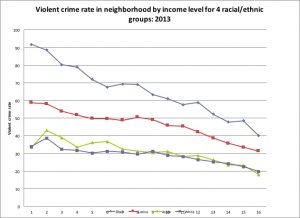 In this Report, we are particularly interested in how economic resources and racial/ethnic status might interact to affect access to various types of neighborhoods. Thus, whereas a particular racial/ethnic group may tend to live in a neighborhood with less favorable conditions compared to another group, the question we ask is whether economic resources can diminish this gap? Specifically, do greater economic resources for racial/ethnic groups that are typically more disadvantaged (e.g., Blacks, Latinos) similarly provide them access to similar neighborhoods as they might for more advantaged groups such as White residents?
In this Report, we are particularly interested in how economic resources and racial/ethnic status might interact to affect access to various types of neighborhoods. Thus, whereas a particular racial/ethnic group may tend to live in a neighborhood with less favorable conditions compared to another group, the question we ask is whether economic resources can diminish this gap? Specifically, do greater economic resources for racial/ethnic groups that are typically more disadvantaged (e.g., Blacks, Latinos) similarly provide them access to similar neighborhoods as they might for more advantaged groups such as White residents?
This Report therefore focuses on the characteristics of neighborhoods occupied by members of racial/ethnic groups based on different levels of income. For example, we compare the characteristics of the neighborhoods of high income white residents to those of high income black residents to high income Asian residents to high income Latino residents. Likewise, we compare the neighborhoods of different racial groups based on other income levels (very low income, low income, medium income, etc.). We also compare within racial/ethnic groups: for example, do high income Blacks live in different neighborhoods compare to low income Blacks? In short, to what extent do race and economic resources—either separately or in tandem—affect the type of neighborhoods that residents are able to access?
Download the full report here (.pdf)